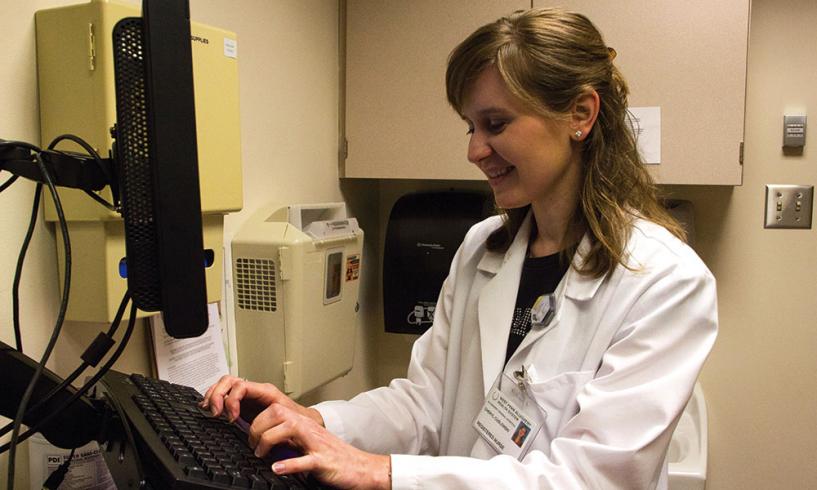As a research associate for ONS, I participated on a panel of oncology experts advising a group of undergraduate and graduate students regarding the lived experience of cancer treatment for older adults. The students, attending Carnegie Mellon University (CMU) in Pittsburgh, PA, were aspiring computer scientists taking a course called Rapid Prototyping of Computer Systems; they developed the following research question based on input from the expert panel.
“How can care coordinators keep patients healthy, happy, independent, and safe at their home with context-aware computing technology?”
Context-Aware Computing Technology
The student scientists used existing technology to create a prototype of what telemonitoring could look like in the near future. I provided background on treatment-related symptoms and interventions with a focus on the importance of maintaining physical activity during and after treatment, including walking, flexibility, and strength-building activities. I explained that physical activity was critical during and after treatment for cancer—but safety is always concern with physical activity during cancer treatment. Using context-aware technology, I would want to know about patient falls in the home that may otherwise go unreported as well as the amount of sedentary activity versus routine activity versus exercise that a patient engages in. How did a patient’s vital signs react to activity? The list of “wants” from the expert panel grew, and none of us (nurse, physician, or care technician) ventured far from the issue of safety and automated reporting of issues to the oncologists and nurses.
CMU students designed a system architecture, including physiologic sensors and location/activity sensors, that connected to a mobile device via Bluetooth. They called their design Bird’s Eye Care. Bluetooth technology transmitted data to a home router, and a local personal computer (PC) pushed and retrieved queries to three user dashboards: patient, caregiver, and care coordinator.
The physiologic and location/activity sensors captured Ecologic Momentary Assessment (EMA) data: a near-constant monitoring of key environmental factors the experts described for the students. Based on our feedback, the students identified key EMAs for tracking in Bird’s Eye Care.
- Pain (limitations, location, intensity)
- Mood (sleep quality, mood, illness, feelings)
- Nutrition (number of meals, fluid intake, appetite)
- Social activity (phone activity, grocery shopping, visitors, outside activity)
Students also identified software that would prompt patients to report mood and nutrition on surveys. Project Bird’s Eye Care would use heart rate monitors, scales, pillboxes, and activity monitors (e.g., Fitbit, Jawbone) that would connect to the internet of things and easily aggregate data. Motion detectors placed throughout living areas would track movement and potentially identify falls and gait issues, and electronic pillboxes would monitor adherence to medication regimes. Sensor data would be pulled into the dashboard to notify the care coordinator and family caregivers of changes in patient data.
In May 2016, the CMU students presented project Bird’s Eye Care to the oncology experts. Their project represented an integrated system designed to monitor patients receiving complex care regimes with a high degree of safety at home. I was proud of their work, but I’m wondering if you are experiencing the same reaction that I did?
Today’s Telemedicine Reality
If all of this technology exists, why aren’t people with cancer and their families benefiting more from telemonitoring and telemedicine? Bird’s Eye Care clearly offers the promise of better care and lower cost.
Experts agree that telemedicine and telemonitoring in oncology would indeed improve access to care and lower costs by reducing emergency department use and inpatient admissions. Despite its promise, considerable barriers to wide scale implementation of teleoncology exist.
Cost: How do providers get paid to cover the cost of telemedicine or telemonitoring? Qualifying for payment is pretty complicated. Medicare is the largest single payer of care for older adults in the United States, but payment for telemedicine is limited to providers in rural areas meeting certain population density criteria (Doyle-Lindurd, 2016). This is a serious limitation to such potentially beneficial technology. Although advanced cancer rates at diagnosis are higher and cancer screening rates lower in rural areas of the country, access to care is certainly a challenge based on other socioeconomic and sociodemographic categories. Oncology nurses need to advocate for changing federal regulations guiding payment for telemedicine to promote a culture of safety. Educating lawmakers, patients, and families about these issues can also help improve access to technology-based oncology care.
Licensure: Medical and nursing licensure requirements vary by state, and telemedicine should be able to cross state lines to achieve maximum effectiveness. Doyle-Lindrud reported that laws currently require providers to be licensed in the state where a patient is receiving treatment. Driving to a neighboring state for a consultation is covered service because care is provided in that state, but a telemedicine visit with the same oncology provider virtually examining the patient across the state line would not necessarily qualify as a covered service. Again, this represents an opportunity for oncology nurses to advocate for change through legislative pathways and to educate patients and families.
Telemedicine and telemonitoring provided by physicians, advanced practice nurses, and RNs improves the quality and safety of care by enhancing access to care, decreasing cost of care, and improving patient satisfaction. Decreasing visits to acute care facilities through telemedicine also reduces the risk of hospital-acquired conditions for patients.






